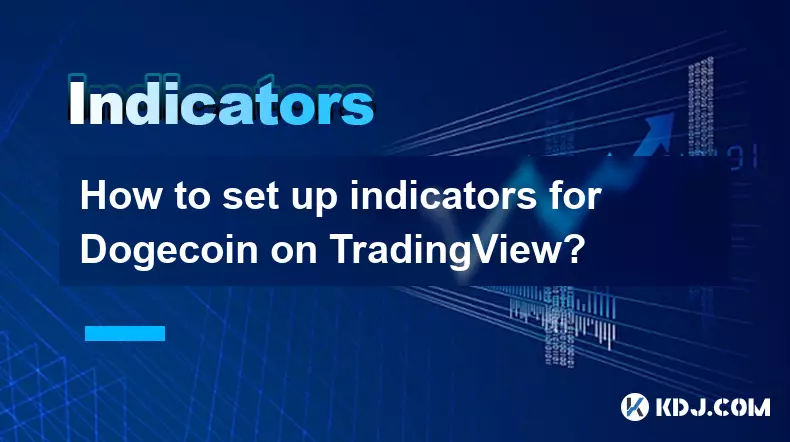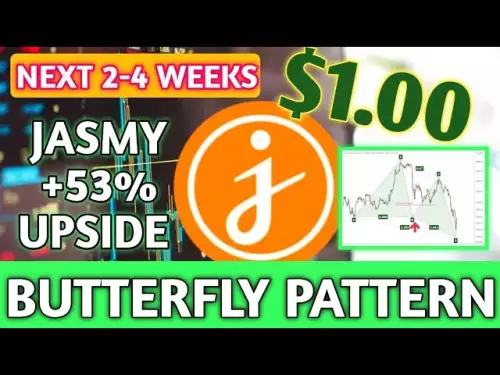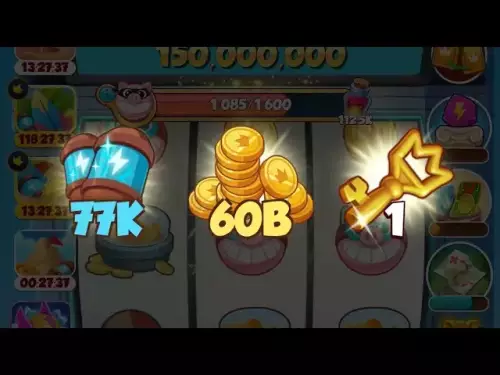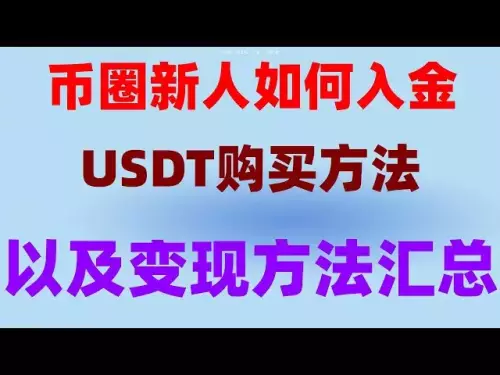-
 Bitcoin
Bitcoin $109500
-2.65% -
 Ethereum
Ethereum $4367
-7.16% -
 XRP
XRP $2.866
-4.11% -
 Tether USDt
Tether USDt $1.001
0.08% -
 BNB
BNB $834.2
-3.96% -
 Solana
Solana $186.7
-8.35% -
 USDC
USDC $0.9998
0.00% -
 TRON
TRON $0.3407
-4.70% -
 Dogecoin
Dogecoin $0.2086
-8.02% -
 Cardano
Cardano $0.8338
-6.54% -
 Chainlink
Chainlink $23.32
-8.27% -
 Hyperliquid
Hyperliquid $42.61
-6.17% -
 Ethena USDe
Ethena USDe $1.001
0.04% -
 Stellar
Stellar $0.3846
-4.40% -
 Sui
Sui $3.346
-7.20% -
 Bitcoin Cash
Bitcoin Cash $542.2
-6.29% -
 Avalanche
Avalanche $23.25
-8.12% -
 Hedera
Hedera $0.2314
-5.09% -
 UNUS SED LEO
UNUS SED LEO $9.576
-0.02% -
 Litecoin
Litecoin $109.6
-5.50% -
 Toncoin
Toncoin $3.120
-4.62% -
 Shiba Inu
Shiba Inu $0.00001198
-6.25% -
 Uniswap
Uniswap $9.635
-10.26% -
 Polkadot
Polkadot $3.731
-7.97% -
 Dai
Dai $1.000
-0.01% -
 Cronos
Cronos $0.1536
-1.37% -
 Bitget Token
Bitget Token $4.465
-3.57% -
 Monero
Monero $263.8
-3.16% -
 Aave
Aave $316.1
-8.24% -
 Ethena
Ethena $0.6228
-8.35%
What does it mean when the MACD and signal lines are close together?
When the MACD and signal lines converge, it signals weakening momentum in crypto markets, often preceding a breakout or reversal—watch for volume and price confirmation before acting.
Aug 05, 2025 at 08:49 pm

Understanding the MACD and Signal Line Basics
The Moving Average Convergence Divergence (MACD) is a widely used technical indicator in cryptocurrency trading that helps traders identify momentum, trend direction, and potential reversal points. It consists of three components: the MACD line, the signal line, and the histogram. The MACD line is calculated by subtracting the 26-period Exponential Moving Average (EMA) from the 12-period EMA. The signal line, on the other hand, is a 9-period EMA of the MACD line itself. When these two lines are close together, it suggests a narrowing gap between the short-term and longer-term momentum of the asset.
The proximity of the MACD and signal lines reflects a state of low momentum divergence. This typically occurs when the recent price action is consolidating or moving sideways. In the context of cryptocurrency markets, which are known for their high volatility, such a condition may signal a temporary pause in a trend. Traders interpret this closeness as a potential precursor to a breakout or breakdown, depending on subsequent price action and volume.
What Does a Narrow Gap Indicate?
When the MACD line and signal line converge, it often means that the momentum behind the current price movement is weakening. In cryptocurrency trading, where rapid price swings are common, this convergence can be a critical warning sign. For instance, if the price has been rising sharply and the MACD lines begin to draw closer, it may indicate that the bullish momentum is losing strength. Conversely, during a downtrend, a narrowing gap could suggest that selling pressure is subsiding.
This convergence does not necessarily imply a reversal. Instead, it highlights a momentum equilibrium where neither buyers nor sellers are gaining significant ground. The histogram, which visualizes the distance between the MACD and signal lines, will appear flat or near zero during this phase. In practical terms, traders should watch for a subsequent divergence—either upward or downward—as a confirmation of renewed momentum.
How to Interpret This in Live Crypto Charts
To observe this phenomenon, open a cryptocurrency chart on platforms like TradingView or Binance. Select the MACD indicator from the studies menu. You will see two lines in the sub-window below the price chart: the faster MACD line (usually blue) and the slower signal line (usually orange). When these two lines move toward each other and nearly touch, pay close attention to the following:
- Check the price action for signs of consolidation, such as small candlesticks or a tight trading range.
- Look at the volume—declining volume during convergence often supports the idea of weakening momentum.
- Monitor the histogram bars—they should be shrinking in height, approaching the zero line.
This setup is common before major news events or before a large whale transaction influences the market. For example, if Bitcoin has been in a strong uptrend and the MACD and signal lines start converging, it may precede a period of indecision before the next leg up or a correction.
Practical Trading Strategy Using Convergence
Traders can use the convergence of the MACD and signal lines as part of a broader strategy. Here’s how to set up a trade based on this signal:
- Wait for convergence near a key support or resistance level on the price chart.
- Confirm with another indicator, such as the Relative Strength Index (RSI) or Bollinger Bands, to avoid false signals.
- Observe the histogram—if it flattens and then begins to expand again, it signals renewed momentum.
- Enter a trade when the MACD line crosses above or below the signal line after the convergence, depending on the direction of the breakout.
- Set a stop-loss just beyond the recent swing point to manage risk.
For instance, if Ethereum is trading in a range and the MACD lines converge near the middle of the range, a breakout above resistance accompanied by the MACD line crossing above the signal line could be a valid long entry. Conversely, a drop below support with the MACD crossing downward may signal a short opportunity.
Common Misinterpretations and How to Avoid Them
A frequent mistake is assuming that convergence alone is a reversal signal. This is incorrect. The mere closeness of the MACD and signal lines does not guarantee a trend change. It only indicates reduced momentum. Acting prematurely can lead to losses, especially in choppy crypto markets.
To avoid false signals:
- Do not trade based on MACD convergence without price confirmation.
- Avoid using this signal in isolation—combine it with support/resistance levels or candlestick patterns.
- Be cautious during low-liquidity periods, such as weekends, when convergence might reflect thin trading rather than genuine momentum loss.
- Remember that different timeframes show different convergence behaviors—what looks like convergence on a 1-hour chart may be part of a larger trend on the daily chart.
Setting Up MACD Alerts for Convergence
Many trading platforms allow users to set custom alerts for technical conditions. To monitor when the MACD and signal lines are close, follow these steps:
- Open your preferred charting tool (e.g., TradingView).
- Apply the MACD indicator if not already visible.
- Click on the "Alerts" button or bell icon.
- Create a new condition using the formula:
abs(macd - macd_signal) < threshold. - Set the threshold to a small value, such as 0.01, depending on the asset’s price scale.
- Choose notification options (email, push, etc.).
- Save the alert.
This way, you’ll be notified whenever the lines are within the specified range, allowing timely analysis without constant chart monitoring.
Frequently Asked Questions
What is the ideal threshold for detecting MACD and signal line convergence?
The threshold depends on the cryptocurrency and timeframe. For high-priced assets like Bitcoin, a threshold of 0.1 to 0.5 may work. For lower-priced altcoins, use 0.01 to 0.05. Adjust based on historical convergence patterns observed in backtesting.
Can MACD convergence occur during a strong trend?
Yes. Even in strong trends, temporary convergence can happen during pullbacks or minor consolidations. It does not automatically negate the trend. Always assess the broader context, including higher timeframe trends and volume.
Is MACD convergence more reliable on certain timeframes?
Generally, convergence on higher timeframes like 4-hour or daily charts carries more weight than on 5-minute or 15-minute charts. Shorter timeframes are more prone to noise and false signals due to market microstructure.
Does MACD convergence work the same across all cryptocurrencies?
The mechanics are identical, but effectiveness varies. Highly volatile or low-liquidity coins may show frequent, misleading convergence. It performs better on major coins like Bitcoin and Ethereum with consistent trading volume.
Disclaimer:info@kdj.com
The information provided is not trading advice. kdj.com does not assume any responsibility for any investments made based on the information provided in this article. Cryptocurrencies are highly volatile and it is highly recommended that you invest with caution after thorough research!
If you believe that the content used on this website infringes your copyright, please contact us immediately (info@kdj.com) and we will delete it promptly.
- Heritage Distilling's Token Deal: A Bold Balance Sheet Strategy
- 2025-08-26 06:45:14
- Coinbase Hack, Solana Shenanigans, and Wallet Woes: What's a Crypto OG to Do?
- 2025-08-26 06:45:14
- Bitcoin, Institutional Adoption, and Volatility: A 2025 Perspective
- 2025-08-26 08:05:14
- MAGACOIN, Ethereum, and XRP Growth: What's the Buzz?
- 2025-08-26 08:30:13
- ETHZilla's Bold Moves: Share Buyback and Ethereum Holdings Under Scrutiny
- 2025-08-26 08:05:14
- Cardano, ADA Price, and the ETH L2 Meme Coin Frenzy: What's Next?
- 2025-08-26 08:50:13
Related knowledge

How to set up indicators for Dogecoin on TradingView?
Aug 25,2025 at 04:23pm
Understanding Dogecoin and TradingView1. Dogecoin, initially created as a meme-based cryptocurrency, has evolved into a widely traded digital asset. I...

What does it mean when the +DI and -DI cross frequently in the DMI indicator but the ADX is flattening?
Aug 11,2025 at 03:15am
Understanding the DMI Indicator ComponentsThe Directional Movement Index (DMI) is a technical analysis tool composed of three lines: the +DI (Positive...

What does the sudden appearance of a "dark cloud cover" candlestick pattern during an uptrend indicate?
Aug 13,2025 at 11:35am
Understanding the 'Dark Cloud Cover' Candlestick PatternThe dark cloud cover is a bearish reversal pattern in technical analysis that typically appear...

What does it mean when the moving average, MACD, and RSI all send buy signals simultaneously?
Aug 11,2025 at 01:42pm
Understanding the Convergence of Technical IndicatorsWhen the moving average, MACD, and RSI all generate buy signals at the same time, traders interpr...

What does it mean when both the KDJ indicator and the RSI show overbought signals simultaneously?
Aug 13,2025 at 11:35am
Understanding the KDJ Indicator in Cryptocurrency TradingThe KDJ indicator is a momentum oscillator derived from the Stochastic Oscillator, widely use...

What does it mean when the price is trading above the SAR indicator but the red dots are densely packed?
Aug 09,2025 at 11:49pm
Understanding the SAR Indicator and Its Visual SignalsThe SAR (Parabolic Stop and Reverse) indicator is a technical analysis tool used primarily to de...

How to set up indicators for Dogecoin on TradingView?
Aug 25,2025 at 04:23pm
Understanding Dogecoin and TradingView1. Dogecoin, initially created as a meme-based cryptocurrency, has evolved into a widely traded digital asset. I...

What does it mean when the +DI and -DI cross frequently in the DMI indicator but the ADX is flattening?
Aug 11,2025 at 03:15am
Understanding the DMI Indicator ComponentsThe Directional Movement Index (DMI) is a technical analysis tool composed of three lines: the +DI (Positive...

What does the sudden appearance of a "dark cloud cover" candlestick pattern during an uptrend indicate?
Aug 13,2025 at 11:35am
Understanding the 'Dark Cloud Cover' Candlestick PatternThe dark cloud cover is a bearish reversal pattern in technical analysis that typically appear...

What does it mean when the moving average, MACD, and RSI all send buy signals simultaneously?
Aug 11,2025 at 01:42pm
Understanding the Convergence of Technical IndicatorsWhen the moving average, MACD, and RSI all generate buy signals at the same time, traders interpr...

What does it mean when both the KDJ indicator and the RSI show overbought signals simultaneously?
Aug 13,2025 at 11:35am
Understanding the KDJ Indicator in Cryptocurrency TradingThe KDJ indicator is a momentum oscillator derived from the Stochastic Oscillator, widely use...

What does it mean when the price is trading above the SAR indicator but the red dots are densely packed?
Aug 09,2025 at 11:49pm
Understanding the SAR Indicator and Its Visual SignalsThe SAR (Parabolic Stop and Reverse) indicator is a technical analysis tool used primarily to de...
See all articles

























































































